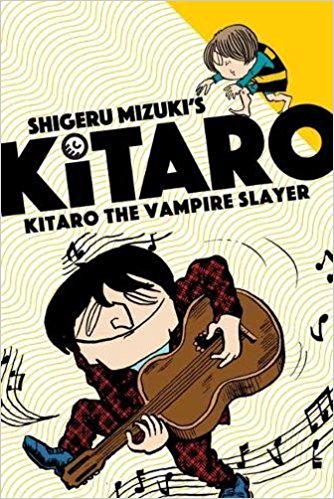By Shigeru Mizuki. Released in Japan as “Gegege no Kitaro” by Kodansha and Shogakukan, serialized in various magazines. Released in North America by Drawn & Quarterly. Translated by Zack Davisson.
I’m sure that if I looked at my previous reviews of Kitaro they would find me saying the same thing as I’m about to say here, so I apologize for the repetition, but I love Nezumi Otoko. He is the number one reason to read this series, even more than the cool adventure plots of the weird, goody and terrifying yokai. And that is simply because he is SO TERRIBLE. He is just the worst. When Mizuki wrote his Hitler book, and needed a narrator who could enchant the reader while still being able to get away with throwing his arms around Hitler as if they’re buddies, there was only one real choice. This volume shows Mezumi Otoko getting in a fight with Kitaro (meaning he slaps him across the chops – his signature move), team up with the titular vampire, sell out his friend and have Kitaro reduced to a skull, etc. Even when he is supposedly on the side of our hero, you’re reminded that his stench is repellent and his farts are lethal. He’s so much fun.
In non-Nezumi Otoko discussion of this new volume of Kitaro, I admit that when I saw the cover, I was expecting more of a Beatles parody than I actually got. Sure the vampire has a Beatle haircut, and carries a guitar with tempting music, but otherwise he’s just a garden-variety Mizuki villain. Not that this is entirely a bad thing, as Mizuki’s yokai can be real pieces of work – Kitaro needs a lot of help to triumph here. There’s also a second vampire story in the book involving, of all things, a vampire Marilyn Monroe. Kitaro needs a lot of help here as well – in fact, in this book, his eyeball father may get more heroic things to do than he does. But sadly, such is the way of adventure thrillers, where the new villain has to be shown to be impressive by making mincemeat of the hero – at first.
The last two stories in the book feature Kitaro in a bit more of a heroic mode. All the stories, however, are exemplary in their economy. The non-yokai cast may be a bit bland – honestly, between the dialogue and the hangdog expressions he gives everyone you’d be forgiven for thinking that all the humans in Kitaro’s universe speak in a monotone – but there’s something happening on every page, and we rarely get too many subplots or sidesteps, even in the longer tales such as the title one. These stories are not really here to make people debate backstory or create Kitaro High School AU fanfiction, like other, more modern manga. They tell a story well, fast, and then move on to the next story. As such, Kitaro should be a lot of fun to anyone who enjoys reading a good story. And, as previously stated, they have Nezumi Otoko. Who is just awful. Seriously.

